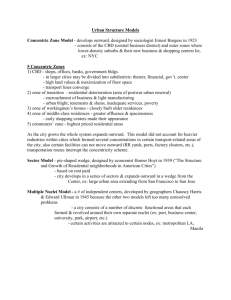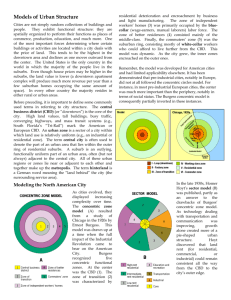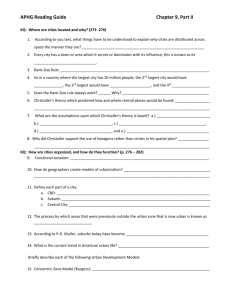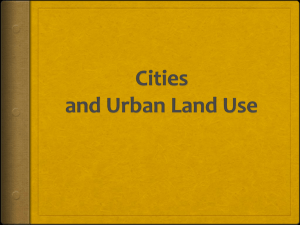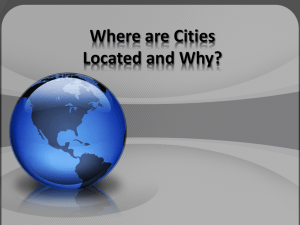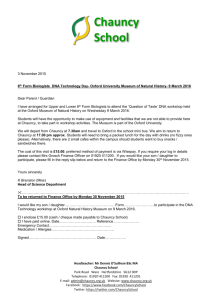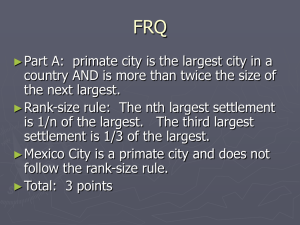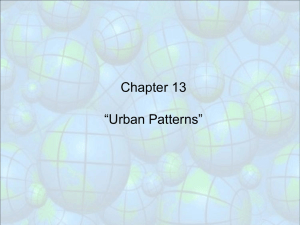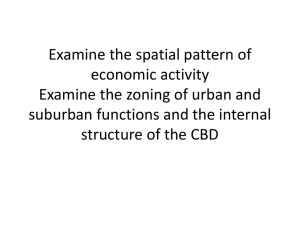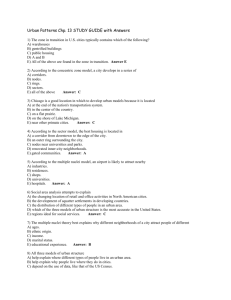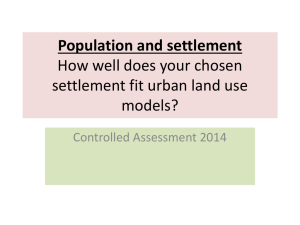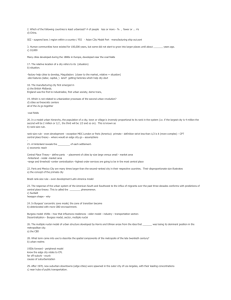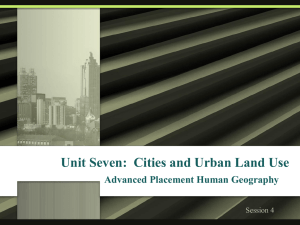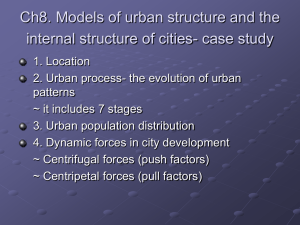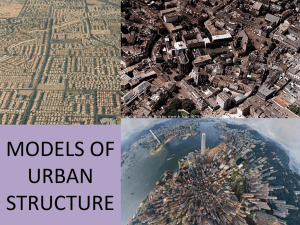Chapter 13 Part 3
advertisement
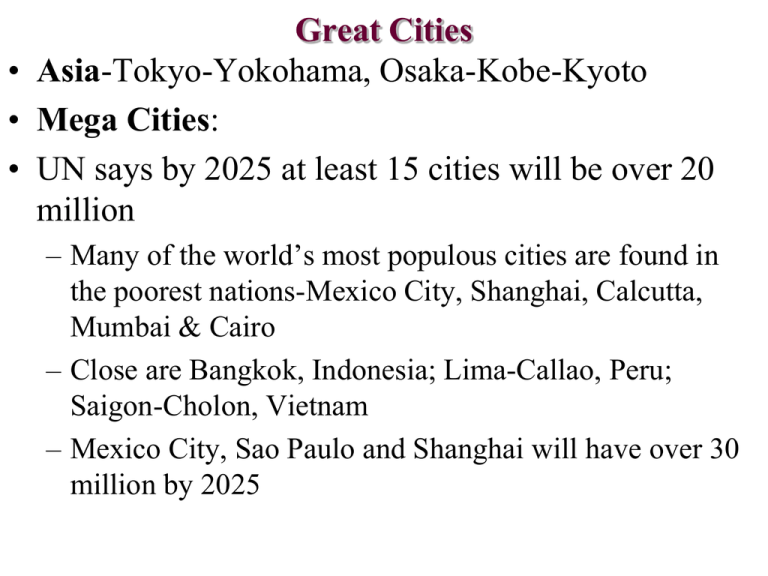
Great Cities • Asia-Tokyo-Yokohama, Osaka-Kobe-Kyoto • Mega Cities: • UN says by 2025 at least 15 cities will be over 20 million – Many of the world’s most populous cities are found in the poorest nations-Mexico City, Shanghai, Calcutta, Mumbai & Cairo – Close are Bangkok, Indonesia; Lima-Callao, Peru; Saigon-Cholon, Vietnam – Mexico City, Sao Paulo and Shanghai will have over 30 million by 2025 Pull Factors • Pull factors often more imaginary that real-esp. in less developed areas. • 1990s Africa had the fastest growing cities in the world-followed by South Asia, East Asia, South and Middle America. • Cities of North America, Southern South America, Australia grew more slowly • Western Europe’s cities grew very little if at all. • New York was the world’s largest city for many years-now overtaken by Tokyo-Mexico City will overtake Tokyo-by 2025 NYC will not be in top 10. Urban Problems • Zoning laws are lacking in many poor countries • Squatters occupy any open space on the outskirts of the city • Sharp contrast between fancy hotels of downtown and slums on outskirts • Cairo for example-paved streets give way to dusty alleys, tenements, traffic, garbage & 12.5 m. people bursting at the seams • Many cities in developing nations are growing at a rapid rate with many new arrivals each day. • Unofficial suburbs such as this favela of Rio de Janeiro are poor and often lack basic services. (Disamenity sector) • Clinging to a hillside, this neighborhood often suffers fatal landslides during heavy rains. Rank-Size Rule • The larger the city-the fewer there are• Model indicates that the population of a city or town in inversely proportional (the fraction) to its rank in the hierarchy • If largest city is 12 million then 2nd largest is 6 m. (1/2) 3rd largest is 4 m. (2/3) 4th largest is 3 m. or (3/4) 10th largest is 1.2 million Rank-Size Rule does Not apply to primate Cities such as Paris, Mexico City and so forth Urban Function • Every city or town has an economic base. • Basic sector-workers who produce goods for export or local consumption • Non Basic sector or Service sector-workers who maintain the city, work in offices and provide services for others • The number of Non basic sector workers is always greater than Basic sector workers-as cities increase in size the ratio increases • Most large cities have a ratio of 1 to 2 • Multiplier Effect-if a business adds 50 manufacturing jobs-another 100 non-basic workers will be added to the work force Functional Specialization • A dominant service or industry was found in many cities during the Industrial Revolution. • Chauncy Harris wrote “A Functional Classification of Cities in the United States” in 1943-in it he described the concentration of manufacturing cities in the Northeast with functional specialization and the wide diversity of western cities with no dominant function • e.g. Detroit-automobiles, Pittsburgh-steel • Las Vegas and Atlantic City gambling • Leadville, Colorado-mining • Vero Beach, Florida-resorts • Trend today is toward diversity-especially in the Rustbelt. Central Place Theory • Central Places-hierarchy is based on population, function & services. • Economic reach-how functions & services attract customers from areas beyond the urban limits. • Centrality-the central position & ability to attract customers to a village, town or city. • Range of Sale-the distance people are willing to travel to buy goods or services Central Place Theory • Christaller tried to determine the degree of centrality of various places. • He created a model to show how central places in the urban hierarchy are spatially distributed. • He assumed: – No physical barriers – Soil and surface of equal quality – Even distribution of population – Uniform transportation system Hexagonal Hinterlands • Christaller’s urban model showed that each central place had a complementary hinterland. • The hexagonal model solves the overlap problem that circles would have. • Nesting arrangementregion within a regioneach larger complementary region is centered on a higher order urban place Central Business District • Downtown-the core of the city with high-rise skyscrapers, heavy traffic, production, education, services etc. • The CBD is the urban area of commercial & industrial zones within a ring of residential areas. • Suburb-an outlying residential area of the urban region that is most pronounced in the US Bid Rent • The price paid to rent or purchase urban land is a reflection of its utility or usefulness. • Utility is a product of accessibility to customers & workers or for residents to jobs and amenities. Modeling the North American City • Concentric zone model (Ernest Burgess) • Sector model (Homer Hoyt) • Multiple Nuclei Model (Chauncy Harris and Edward Ullman) Classic Models of Urban Structure • Ernest Burgess-1925 Concentric Zone Model based on studies of Chicago. • CBD-financial, retail, theater, museums etc. • Transition to residential with deterioration-some light industry • Blue collar labor housing • Middle class residential • Suburban ring Functional Zonation The division of the city into certain regions (zones) for certain purposes (functions). Cairo, Egypt Central city (above) Housing projects (right) Classic Models of Urban Structure • Homer Hoyt-1939 Sector Model based on studies of 142 US cities. • Pie-shaped wedges created by Hoyt compensated for the drawbacks of the Ring Model • Low Rent areas & High Rent areas could extend to the outer edge • Transportation and industrial zones accounted for the sectors • Chauncy Harris & Edward Ullman Multiple Nuclei Sector Model 1945 showed that CBD is not the sole force in creating land-use patterns. • They said that Concentric Rings & Pie-shaped models had drawbacks as CBDs were losing dominance • Subsidiary and competing CBDs developed (Edge Cities) • Suburbanization accelerated the change with shopping malls and mass transit Why Do Inner Cities Still Attract People? Recreational facilities Orchestras, theaters and venues for popular music concerts Museums and art galleries Sport teams and sporting arenas Banks and high finance institutions Universities and research facilities Specialized research hospitals and medical specialists Shopping and specialized stores Making Cities in the Global Core • Redlining – financial institutions refusing to lend money in certain neighborhoods. • Blockbusting – realtors purposefully sell a home at a low price to an African American and then solicit white residents to sell their homes at low prices, to generate “white flight.” Problems in Urban America 200 years ago only 5% of world was urbanized Today about 50% is urban Germany, Spain & Belgium are over 90% urban World wide urban problems are: pollution poor sanitation drugs and crime congestion and noise substandard housing & slums Problems in Urban America • With urban sprawl and expanding suburbs-inner city shrinks • CBD is often reduced to serving just the inner metro area • As basic sector jobs leavelarge cities have shifted to service industries • Loss of tax base as businesses, industries and services leave • Urban decay results Problems in Urban America • New York City a good example: – 3 million people plus uncounted illegals crowd into 75 to 100 year old apartment buildings – Many buildings are worn out, rat & roach infested with high crime rates, vandalism and cases of spouse & child abuse • Yet despite the problems there is a sense of community that may be lost if the neighborhood is torn down • Deglomeration-as globalization and improved communication and transportation have developed-many businesses leave the high costs of downtown since it is no longer an advantage to cluster with other similar businesses-the results are rustbelt cities with urban decay, loss of tax revenue and abandoned property Making Cities in the Global Core • Gentrification – individuals buy up and rehabilitate houses, raising the housing value in the neighborhood and changing the neighborhood. • Commercialization – city governments transform a central city to attract residents and tourists. The newly commercialized downtowns often are a stark contrast to the rest of the central city.

